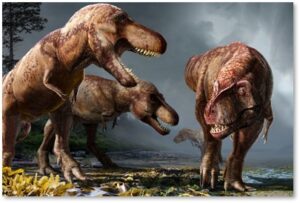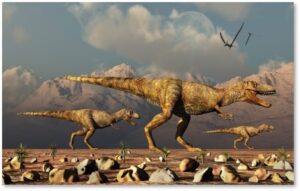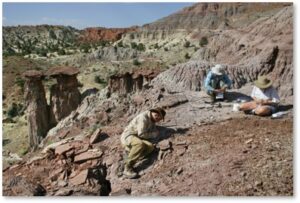We’ve had killer bees and murder hornets, man-eating sharks and whale-killing orcas, but when it comes to sheer terror, these creatures pale in comparison to a hunting pack of Tyrannosaurs Rex dinosaurs.
Two new studies have given us more information on the life and behaviors of these giant predatory dinosaurs. Having different goals, they delivered different conclusions:
- More of them existed than we had previously thought
- They probably hunted in packs.
If the idea of a hunting pack of peckish apex predators doesn’t frighten you, consider one that’s roaming within commuting distance. If you were running a marathon back then, you would likely have encountered a Tyrannosaurus pack somewhere along the route. In that case, you would have had to run much, much faster.
The Tyrannosaurus Population
 A new study published in Science magazine analyzed the existing fossils not in private hands and determined that about 2.5 billion Tyrannosaurs lived in the Cretaceous Period.
A new study published in Science magazine analyzed the existing fossils not in private hands and determined that about 2.5 billion Tyrannosaurs lived in the Cretaceous Period.
Before you picture mobs of these creatures blanketing the Earth and gobbling up everything in sight, consider that this number covers 127,000 generations living over the course of 1.6 to 3.2 million years.
Paleontologist Charles Marshall gives us a ballpark figure of about 20,000 adult T-Rexes alive at any given time. Phew, that’s better. I doubt any of us wants to be in a ballpark with a T-Rex, though.
The study estimates that Washington DC would have been home to just two of these beasts. (I would have thought we’d have more in the Congress alone.) While California would have housed a population of about 3,800. As if that state’s earthquakes, wildfires, droughts, and mud slides weren’t bad enough.
Tyrannosaurus Hunting Packs
The Utah Bureau of Land Management announced last week that they had found evidence of “pack-like behavior” among Tyrannosaurus Rex fossils in the Grand Staircase-Escalante National Monument.
Dr. Joe Sertich, curator of dinosaurs at the Denver Museum of Nature & Science, said:
“The new Utah site adds to the growing body of evidence showing that Tyrannosaurs were complex, large predators capable of social behaviors common in many of their living relatives, the birds.”
The Utah discovery strengthens the pack hunting theory because it’s the third mass death site. Other findings of pack formations were discovered in Montana and in Alberta, Canada. There, scientists uncovered more than a dozen of the dinosaurs buried together at a dig site.
Rainbows and Unicorns
Paleontologist Dr. Alan Titus of the US Bureau of Land Management, discovered the “Rainbows and Unicorns” mass death site back in 2014. No, the site held no fossilized unicorn bones. Scientists gave it this whimsical name simply because of the abundance of rare fossils in one place.
Their analysis of the fossil bones and the surrounding rock revealed that the dinosaurs died and were buried together, rather than being washed in from other places.
Still, other scientists contested the pack-hunting idea, arguing that dinosaurs simply did not have the brainpower needed for complex social interaction. Science has long equated big brains with intelligence, however. That was, after all, the whole idea propping up the notion that men were smarter than women. The Tyrannosaurus Rex certainly had enough room in its skull for a big, smart brain. We now know. however, that the composition of the brain is more important than size. So far, no paleontologist as found an intact T-Rex brain.
The Tyrannosaurs Rex might have hunted like wolf packs out west, but I doubt anyone wants to re-introduce them to Yellowstone National Park. Or Jurassic Park, either.
Your Tax Dollars at Work
Note that the Rainbows and Unicorns “death assemblage” site was discovered by a government employee working in a protected national monument. Sometimes our tax dollars deliver more value than we ever expected.
In this time of pandemic anomie and (new term) languishing I really enjoy these tidbits of totally irrelevant information. They add spice to what has become a humdrum existence characterized by feelings of stagnation and emptiness.
And who could remain joyless and aimless when pursued by a Tyrannosaurus Rex hunting pack?


